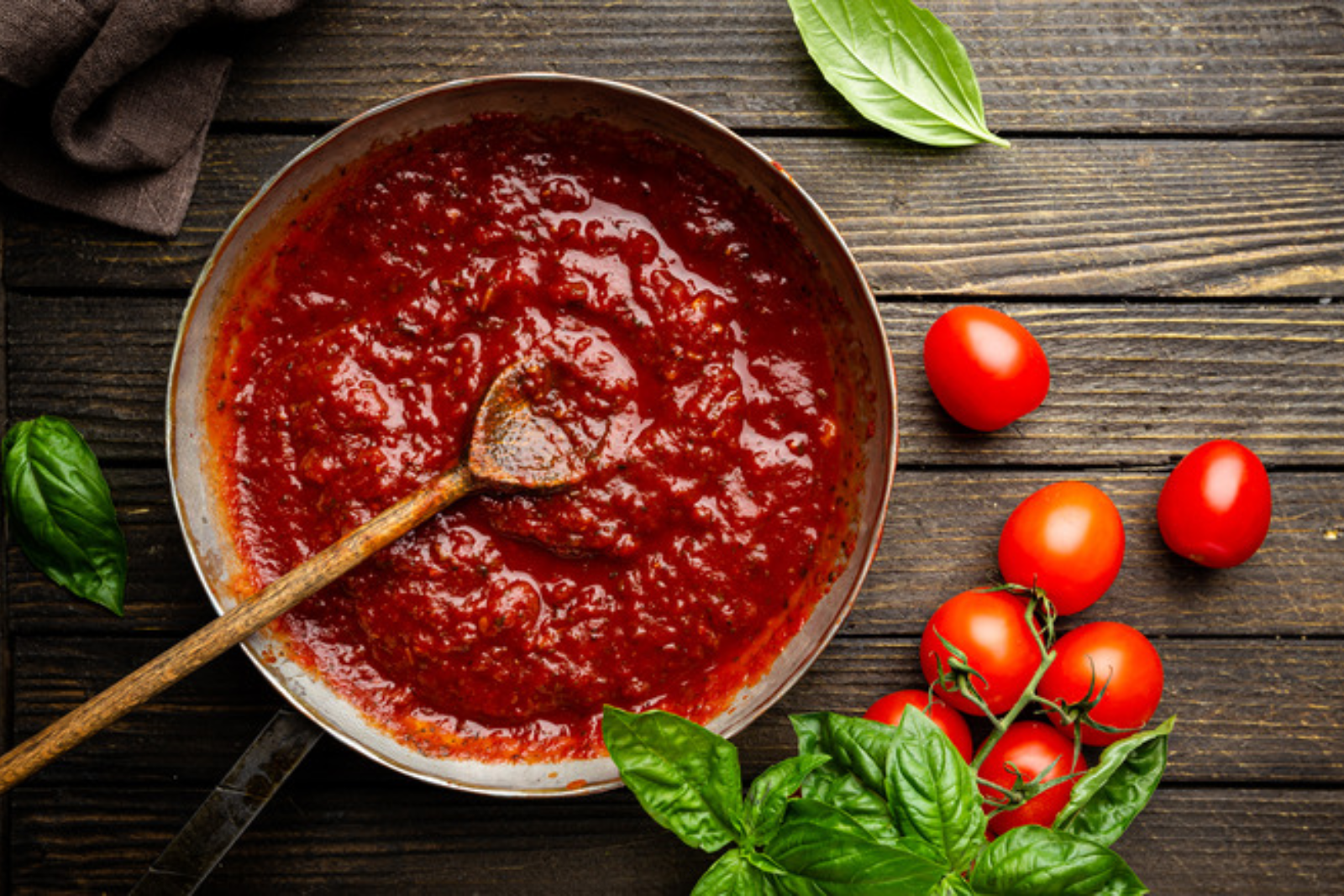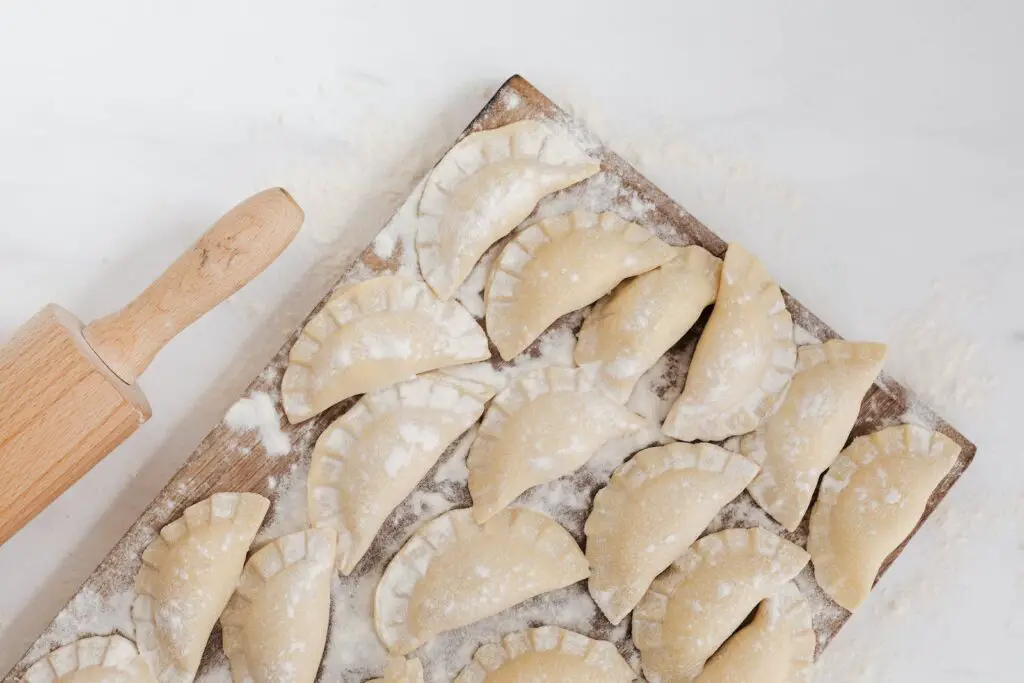
Tomato sauce is a versatile and essential ingredient in many recipes, from pasta dishes to soups and stews. Making a large batch of tomato sauce and freezing it for future use can save you time and effort in the kitchen. Freezing tomato sauce allows you to enjoy the taste of fresh tomatoes even when they are out of season. By following a few simple steps, you can freeze tomato sauce properly and ensure its quality remains intact. This article provides a step-by-step guide on how to freeze tomato sauce for convenient use in your favorite dishes.
Here’s a guide on how to freeze tomato sauce:
Step 1: Prepare the tomato sauce
When it comes to freezing tomato sauce, the first step is to prepare the sauce itself. You have the option to either make the sauce from scratch using fresh tomatoes or utilize canned tomato products, depending on your preference and availability.
If you decide to make the tomato sauce from scratch, begin by selecting ripe and flavorful tomatoes. You can choose a variety such as Roma, San Marzano, or heirloom tomatoes for a rich and robust sauce. Wash the tomatoes thoroughly and remove any stems or blemishes.
To prepare the tomatoes for cooking, you have the choice of peeling or leaving the skins on. If you prefer a smoother sauce, blanch the tomatoes by scoring an “X” on the bottom and placing them in boiling water for about 30 seconds. Then, transfer them to an ice bath to cool. The skins can be easily peeled off at this point. However, if you enjoy the texture and added nutrients of tomato skins, you can skip this step.
Next, chop the tomatoes into small pieces. If you prefer a chunkier sauce, you can leave the pieces slightly larger. For a smoother consistency, finely dice or puree the tomatoes using a blender or food processor.
Once the tomatoes are prepared, it’s time to cook them. In a large pot, heat some olive oil over medium heat. Add minced garlic and onions, if desired, and sauté until they become translucent and fragrant. This step adds depth of flavor to the sauce.
Add the chopped tomatoes to the pot and stir well. Season the sauce with salt, pepper, and other herbs and spices of your choice, such as basil, oregano, or thyme. You can also add a pinch of sugar to balance the acidity of the tomatoes.
Allow the sauce to simmer over low heat for at least 30 minutes to an hour, stirring occasionally to prevent sticking. The longer you cook the sauce, the richer and more concentrated the flavors will become. Adjust the seasoning to taste and ensure that the sauce has reached your desired thickness.
If you prefer a smoother sauce without any chunks, you can use an immersion blender or transfer the sauce to a blender or food processor to puree until smooth.
Step 2: Cool the tomato sauce
After preparing your delicious tomato sauce, it’s important to allow it to cool completely before proceeding with the freezing process. This step is crucial for preserving the texture and flavor of the sauce during freezing.
When hot or warm tomato sauce is placed directly into the freezer, it can lead to the formation of ice crystals. These ice crystals can damage the structure of the sauce, resulting in a watery consistency and potentially affecting the taste.
By allowing the tomato sauce to cool, you give it time to reach a lower temperature, reducing the chances of ice crystal formation. Cooling the sauce also helps to stabilize its overall structure and flavor.
To cool the tomato sauce, start by removing it from the heat source. Transfer the sauce to a shallow and wide container or a heat-resistant bowl. The wider the container, the faster the sauce will cool.
To expedite the cooling process, you can place the container in an ice bath. Fill a larger bowl or sink with cold water and ice cubes, and then place the container with the tomato sauce in the ice bath. Stir the sauce occasionally to promote even cooling.
Alternatively, you can let the sauce cool at room temperature. This method takes longer but is still effective. Make sure to cover the container with a lid or plastic wrap to prevent any contamination while the sauce cools.
It’s important to emphasize that the tomato sauce must reach room temperature before refrigerating it or placing it in the freezer. Placing hot or warm sauce directly into the refrigerator or freezer can raise the internal temperature of these appliances, potentially compromising the safety and quality of other foods stored inside.
Step 3: Choose appropriate containers
When freezing tomato sauce, selecting the right containers is essential to maintain the quality and integrity of the sauce. It’s important to choose freezer-safe containers or resealable plastic bags that will protect the sauce from freezer burn and prevent any unwanted flavors or odors from seeping in.
- Freezer-safe containers: Opt for containers specifically designed for freezing food. These containers are made of durable materials such as glass or BPA-free plastic that can withstand low temperatures without cracking or becoming brittle. Make sure the containers have a tight-fitting lid to create an airtight seal, preventing air and moisture from entering.
- Resealable plastic bags: If you prefer using plastic bags, ensure they are specifically labeled as freezer-safe. These bags are made with thicker and more durable materials to withstand freezing temperatures. Look for bags with a strong seal that will prevent leaks and maintain the quality of the tomato sauce.
- Cleanliness: Before using any containers or bags, ensure they are clean and free from any residues, odors, or contaminants. Thoroughly wash the containers with hot, soapy water, and rinse them well. Avoid using containers that previously stored strong-smelling foods as the odor can transfer to the tomato sauce.
- Drying: After washing the containers, make sure they are completely dry before filling them with tomato sauce. Excess moisture can lead to the formation of ice crystals and affect the texture of the sauce. Towel-dry the containers or air-dry them upside down to ensure they are moisture-free.
- Proper sizing: Consider portion sizes and your future needs when selecting containers. It’s advisable to freeze tomato sauce in smaller portions to facilitate thawing and reduce waste. Single-serving or family-sized portions are ideal, depending on your intended usage. Smaller containers also allow for quicker freezing and thawing when needed.
Step 4: Portion the sauce
When freezing tomato sauce, it’s advisable to divide it into smaller portions based on your needs. Freezing the sauce in individual or family-sized servings offers several benefits and makes it more convenient to thaw and use later.
- Ease of thawing: Portioning the tomato sauce allows you to thaw only the amount you need for a particular meal. Instead of thawing the entire batch, you can take out a single portion or multiple portions, depending on your requirements. This eliminates the need to thaw a large quantity and helps minimize waste.
- Flexible usage: By portioning the tomato sauce, you have the flexibility to use it in various dishes without thawing more than necessary. Whether you need a small amount for a quick pasta dish or a larger quantity for a family dinner, having pre-portioned servings makes it easier to adapt to different recipes.
- Reduced reheating: Thawing smaller portions of tomato sauce reduces the reheating time. Smaller servings heat up more quickly and evenly, allowing you to save time in the kitchen. Additionally, it ensures that the sauce reaches the desired temperature without overheating or scorching.
- Preservation of quality: When you freeze the sauce in smaller portions, each serving is exposed to less air and moisture during the freezing and thawing process. This helps maintain the flavor, texture, and overall quality of the tomato sauce. Larger containers may require repeated thawing and refreezing, which can affect the sauce’s taste and consistency over time.
- Portion sizes: Consider your typical usage and the number of servings you usually require. If you frequently cook for a small household, individual-sized portions or smaller containers may be suitable. For larger families or when hosting guests, family-sized portions or medium-sized containers might be more appropriate. Choose portion sizes that align with your cooking habits and preferences.
- Storage efficiency: Portioning the sauce into smaller servings optimizes the use of freezer space. It allows you to stack and organize the containers or bags more efficiently. Additionally, smaller portions freeze faster than larger ones, reducing the risk of freezer burn and ensuring better overall quality.
Can I freeze tomato sauce in ice cube trays?
Yes, freezing tomato sauce in ice cube trays can be a convenient option for small portions or when you want to add a quick burst of tomato flavor to dishes. Once frozen, transfer the tomato sauce cubes to a freezer-safe bag or container for longer-term storage.
Can I freeze tomato sauce in silicone molds?
Yes, freezing tomato sauce in silicone molds can be a convenient way to create portioned servings. Ensure that the molds are freezer-safe and suitable for high temperatures. Once the sauce is frozen in the molds, transfer the sauce portions to a freezer-safe bag or container for long-term storage.
Step 5: Fill the containers
Once you have portioned your tomato sauce, it’s time to fill the containers or resealable plastic bags. Properly filling the containers is important to ensure that the sauce freezes evenly and safely. Here are some guidelines to follow:
- Leaving headspace: Leave some headspace at the top of each container or bag. This empty space is crucial because liquids expand when they freeze. If the container is completely filled, the expanding sauce may cause the container to crack or burst, resulting in leaks or spills in the freezer. Leaving adequate headspace allows room for expansion and prevents damage to the containers.
- Recommended headspace: As a general rule of thumb, leave about ½ inch (1.3 cm) to 1 inch (2.5 cm) of headspace at the top of each container. This measurement may vary slightly depending on the size of the container or bag. Refer to the manufacturer’s instructions if available.
- Even distribution: Distribute the tomato sauce evenly among the containers to ensure consistent freezing and thawing. Use a ladle or spoon to transfer the sauce, pouring it carefully into each container or bag. Take your time to avoid spills or splatters.
- Avoid overfilling: Resist the temptation to overfill the containers, as this can lead to messy spills or leaks during freezing and thawing. Stick to the recommended headspace, even if it means using an additional container for any excess sauce. It’s better to have extra containers than to risk a messy freezer or compromised sauce quality.
- Sealing properly: After filling each container or bag with the tomato sauce, securely seal them to create an airtight barrier. For containers, ensure that the lids are tightly closed. If using resealable plastic bags, remove as much air as possible before sealing to minimize the potential for freezer burn. A vacuum sealer can also be used for an extra airtight seal.
- Cleanliness: It’s important to maintain cleanliness during this step. Wipe any spills or drips on the containers’ exteriors to prevent them from sticking to the freezer shelves or affecting the other items stored in the freezer.
Can I freeze tomato sauce in glass jars?
Yes, you can freeze tomato sauce in glass jars, but it’s important to use jars specifically designed for freezing. Leave enough headspace in the jar to allow for expansion during freezing, and ensure that the jar is freezer-safe and can withstand low temperatures. It’s also advisable to cool the sauce completely before filling the jars to prevent thermal shock and potential breakage.
Step 6: Seal the containers
Properly sealing the containers or resealable plastic bags is crucial when freezing tomato sauce. Airtight seals help prevent freezer burn, maintain the sauce’s quality, and preserve its flavor. Here’s why sealing the containers is important:
- Preserving freshness: An airtight seal ensures that the tomato sauce remains fresh during freezing. When exposed to air, the sauce can oxidize, leading to changes in flavor, color, and texture. A tight seal prevents air from reaching the sauce, keeping it in its best possible condition.
- Preventing freezer burn: Freezer burn occurs when food is exposed to air and moisture in the freezer for an extended period. It can cause the sauce to develop a dry, leathery texture and lose its optimal taste. By sealing the containers tightly, you create a barrier that minimizes air contact and reduces the risk of freezer burn.
- Avoiding cross-contamination: A secure seal prevents the transfer of flavors and odors between the tomato sauce and other foods stored in the freezer. It ensures that the sauce retains its authentic taste without being influenced by nearby items.
- Resealable plastic bags: If using plastic bags, ensure they are resealable and specifically labeled as freezer-safe. Before sealing, remove excess air from the bag to minimize the potential for freezer burn. Gently press on the bag to push out the air while leaving enough room for the sauce to expand during freezing. Once most of the air is removed, seal the bag tightly to create a secure closure.
- Containers: For containers, ensure that the lids are securely fastened to create an airtight seal. Double-check that the lids are properly aligned and locked in place. Test the seal by gently pressing down on the center of the lid to ensure it doesn’t pop back up. An airtight seal helps maintain the sauce’s freshness and prevents leaks or spills in the freezer.
- Labeling: After sealing the containers or bags, it’s helpful to label them with the date and contents. This labeling practice allows you to easily identify the tomato sauce in the freezer and keep track of its storage time. It promotes efficient organization and helps prevent forgotten or expired items.
Step 7: Label the packages
Labeling each container or bag of frozen tomato sauce with the date and contents is an important step in the freezing process. It helps you keep track of the sauce’s age, ensures proper rotation of your frozen foods, and makes it easier to identify the sauce in the freezer. Here’s why labeling is essential:
- Tracking storage time: By labeling the packages with the date, you can easily determine how long the tomato sauce has been in the freezer. It allows you to adhere to recommended storage times and consume the sauce within its optimal quality period. This is particularly important for maintaining the flavor and texture of the sauce.
- Preventing waste: Properly labeled packages help prevent unnecessary waste. If you have multiple containers or bags of tomato sauce in the freezer, knowing the date of each package allows you to prioritize older ones for consumption. It reduces the chances of forgetting about a particular batch and allows you to use the sauce before it exceeds its recommended storage time.
- Easy identification: Labeling the packages with the contents makes it simple to identify the tomato sauce in the freezer. It saves you time and effort when searching for a specific item among other frozen foods. You can quickly locate the sauce you need without having to open multiple containers or bags.
- Organizational efficiency: Labeling contributes to an organized freezer space. With clear and visible labels, you can arrange the packages in a systematic manner, making the most of the available space. It helps prevent confusion and ensures that you can access the tomato sauce easily whenever you need it.
- Information reference: The labels also serve as a reference for future use. If you have different variations of tomato sauce, such as marinara, arrabbiata, or bolognese, labeling each package allows you to quickly identify the specific type of sauce you desire. It eliminates any guesswork when selecting the right sauce for your recipes.
When labeling the packages, use a permanent marker or labels that are resistant to moisture and freezer conditions. Write the date clearly and include a brief description of the sauce, such as “Tomato Sauce – Marinara.” Place the labels in a visible area on the containers or bags for easy reading.
Step 8: Freeze the tomato sauce
After properly preparing and packaging your tomato sauce, it’s time to freeze it. The way you arrange the containers or bags in the freezer can affect the freezing process and overall organization. Here’s why it’s important to follow the recommended freezing guidelines:
- Promoting faster freezing: Placing the containers or bags in a single layer allows for faster and more efficient freezing. When items are tightly packed or stacked, it restricts the circulation of cold air within the freezer, leading to slower freezing times. A single layer arrangement ensures that the cold air can evenly surround each container or bag, promoting quicker freezing and preserving the quality of the tomato sauce.
- Maintaining sauce quality: Properly freezing the tomato sauce helps retain its flavor, texture, and nutritional value. Slow freezing or uneven freezing due to overcrowding can result in the formation of large ice crystals, affecting the sauce’s consistency and taste. Freezing the sauce in a single layer minimizes the risk of ice crystal formation and helps maintain its desired quality.
- Preventing spillage and leaks: Stacking containers before they are fully frozen can lead to unstable arrangements and potential spills or leaks. Freezing the containers or bags in a single layer allows them to freeze individually without the risk of toppling over or causing accidents. This helps maintain a clean and organized freezer environment.
- Easier organization: Arranging the containers or bags in a single layer makes it easier to locate and access the desired tomato sauce when needed. It prevents items from becoming buried or hidden in the back of the freezer, saving you time and effort in the future. Additionally, it allows for better visibility and space utilization within the freezer.
To ensure proper freezing, find a flat surface in your freezer, such as a shelf or tray, and place the containers or bags in a single layer. Leave enough space between each item to allow cold air to circulate freely. Avoid stacking or overcrowding until the sauce is fully frozen.
Once the tomato sauce is completely frozen, you can stack the containers or bags to maximize freezer space. Make sure the containers or bags are securely positioned to prevent shifting or damage to other items in the freezer.
Step 9: Store in the freezer
Once you have frozen the tomato sauce, it’s important to store it properly in the freezer to maintain its quality and safety. Here are some guidelines to follow when storing the frozen tomato sauce:
- Optimal temperature: The freezer temperature plays a crucial role in preserving the tomato sauce. Ideally, the freezer should be set at temperatures below 0°F (-18°C). This low temperature prevents bacterial growth and enzymatic activity, ensuring the sauce remains safe and retains its quality for an extended period.
- Avoiding temperature fluctuations: Fluctuating temperatures can negatively impact the texture, flavor, and safety of the tomato sauce. It’s essential to place the sauce in a location within the freezer that is not susceptible to temperature fluctuations, such as the door. The door is more prone to warmer temperatures when opened frequently, which can compromise the sauce’s frozen state and quality.
- Proper packaging placement: Ensure that the tomato sauce containers or bags are placed securely in the freezer, allowing them to remain undisturbed. Avoid stacking other items on top of the sauce to prevent crushing or damage. This will help maintain the sauce’s shape and texture.
- Protection from air and moisture: Freezer burn occurs when frozen food is exposed to air and moisture, resulting in dry, discolored patches on the sauce’s surface. To prevent freezer burn, double-check that all containers or bags are properly sealed and airtight. Avoid leaving any gaps or openings that could allow air or moisture to come in contact with the sauce.
- Organized storage: Arrange the frozen tomato sauce in an organized manner, grouping similar items together and labeling them accordingly. This facilitates easy retrieval and prevents accidental thawing or damage to other frozen foods when searching for the desired sauce.
- Proper rotation: To ensure the best quality, practice the “first in, first out” principle. As you use frozen tomato sauce, make sure to take out the oldest containers first. This way, you can maintain a constant rotation and prevent any sauce from being stored for an excessively long period.
Remember to follow any specific storage guidelines or recommendations mentioned in your recipe or food safety guidelines to ensure the best results.
How long can I freeze tomato sauce?
Properly frozen tomato sauce can be stored in the freezer for approximately 4 to 6 months. However, for the best quality, it’s recommended to use the sauce within 3 months. Over time, frozen tomato sauce may experience flavor and texture changes, so it’s advisable to adhere to the recommended storage times.
Other related questions
How do I defrost tomato sauce?
To defrost tomato sauce, there are a few recommended methods. The safest way is to thaw it in the refrigerator by transferring the container of frozen sauce from the freezer to the fridge and allowing it to thaw slowly overnight or for several hours. Alternatively, you can use the defrost function of a microwave, following the appliance’s instructions, or place the container in a sealed plastic bag and submerge it in cold water, changing the water every 30 minutes until the sauce is thawed.
Can I refreeze tomato sauce?
Yes, you can refreeze tomato sauce as long as it has been handled and stored properly. When thawing previously frozen tomato sauce, it is important to do so in the refrigerator and use it within a safe time frame. Once the sauce has been thawed, it should not be refrozen again, as this can impact its quality and increase the risk of bacterial growth.
How do I know if the tomato sauce has gone bad after being frozen?
To determine if frozen tomato sauce has gone bad, there are a few indicators to look for. Check for any off odors, such as a sour or rancid smell. Additionally, examine the sauce for any unusual discoloration, mold growth, or signs of freezer burn, such as dry or discolored patches. If you notice any of these signs, it is advisable to discard the sauce to ensure food safety and quality.
Can I freeze tomato sauce with added herbs and spices?
Yes, you can freeze tomato sauce with added herbs and spices. However, the flavors of some herbs and spices can intensify during freezing, so it’s best to slightly under season the sauce before freezing. This allows for adjustments and fine-tuning of the flavors when you use the thawed sauce in your recipes.
Can I freeze tomato sauce that has been cooked with onions and garlic?
Yes, you can freeze tomato sauce that has been cooked with onions and garlic. Just make sure that the onions and garlic are cooked thoroughly before adding them to the sauce. This helps enhance their flavors and ensures they freeze well with the sauce.
Can I freeze tomato sauce with added dairy, like cream or cheese?
It’s generally not recommended to freeze tomato sauce with added dairy products like cream or cheese. Dairy can change in texture and separate when frozen and thawed, affecting the overall quality of the sauce. If you plan to use the sauce in dishes that require dairy, it’s better to add the dairy products after thawing and reheating the sauce.








